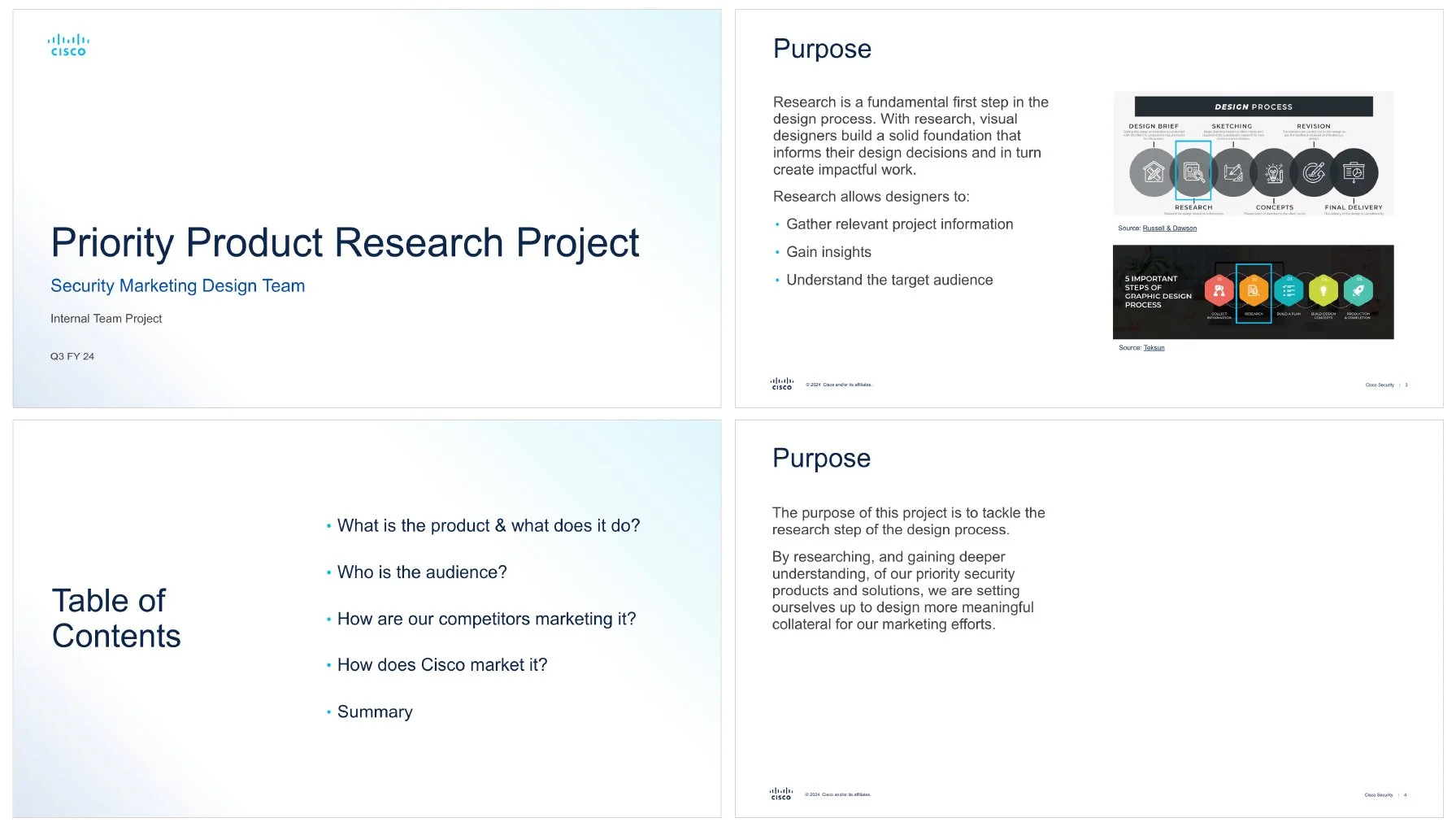Product Research Project: Revitalizing Creative Excellence Through Strategic Focus
When strategic priorities shift, creative teams need more than new assignments — they require a solid foundation to deliver exceptional work that drives business results.
The Challenge
When Cisco's security marketing team shifted from a "market all products" approach to a laser focus on the top 5 priority products, the strategic change created an unexpected operational challenge. As Senior Design Manager, I observed how this prioritization, although strategically sound, pushed my team of graphic designers into a purely production-oriented mode.
The intensified focus exposed critical workflow gaps that directly impacted our creative output:
Creative burnout: Designers were caught in a cycle of execution without conception, leading to team fatigue and diminished job satisfaction
Diluted deliverables: Without proper research and ideation time, our design work lacked the strategic differentiation needed to market distinct products effectively
Visual homogenization: Materials for each product began overlapping in messaging, visuals, and overall design approach despite the need for clear product differentiation
Process breakdown: Our workflow failed to accommodate the essential research and concepting stages of the creative design process
Time constraints: The team consistently felt pressure to deliver without adequate time for the foundational work that drives innovative solutions
As someone who prioritizes my designers' professional growth and well-being, I heard the same concerns echoed across one-on-one meetings: the team needed dedicated time to immerse themselves in understanding our five priority products in order to design effectively for each unique audience and value proposition.
The Solution: Collaborative Product Research Project
Drawing on my graphic design background, I understood that skipping the research and ideation phases leads to inefficient "pixel pushing" without landing on breakthrough creative concepts. This insight shaped my approach to protecting and prioritizing conceptual time for my team.
I developed a structured collaborative research project that would address both our immediate knowledge gaps and long-term creative process needs:
Project Structure
Using our 5 priority products as subjects, I organized the team into research pairs, with each duo conducting deep dives into assigned products. This collaborative approach ensured comprehensive coverage while building cross-team knowledge sharing.
View of intro slides and purpose statement for final deliverable
Research Framework
Each team was tasked with developing complete product understanding across key areas:
Product functionality and unique value propositions
Target audience analysis and user personas
Competitive landscape assessment
Current company marketing positioning and messaging
Market differentiation opportunities
Timeline and Integration
The project spanned three weeks, with dedicated research time built into each designer's weekly schedule. Week three culminated in team-wide readouts where each group shared their findings, facilitating organization-wide knowledge transfer and collaborative learning.
The Impact
The research project delivered transformative results that went far beyond solving our immediate creative challenges. By prioritizing the foundational research phase, we not only restored our team's creative process but also built sustainable systems for ongoing strategic design work.
Outcomes
Product differentiation: The team gained a deep understanding of all 5 priority products, enabling the creation of distinct marketing visuals that maintained brand consistency while achieving clear product differentiation
Creative design process restoration: Designers reconnected with the critical research phase, reinforcing its essential role in producing innovative and strategically aligned creative outcomes
Knowledge centralization: Research findings were compiled into a comprehensive reference document accessible to all team members for ongoing product-related projects
Workflow optimization: Established a sustainable framework for balancing strategic thinking time with production demands
Enhanced collaboration: As a fully remote team, the project fostered new connections between designers who typically interacted only during regular team meetings
Relationship building: One team member noted missing the regular research partnership meetings after project completion, leading to new habits around prioritizing interpersonal connections
Professional development: Designers strengthened research and analysis skills while building confidence in strategic thinking
Key Takeaway
This project succeeded because it addressed the fundamental truth of creative work: exceptional design requires a strategic foundation. By protecting time for research and ideation while creating collaborative learning opportunities, we transformed potential burnout into renewed creative energy and strategic focus. The project demonstrated how understanding the creative design process enables leaders to build supportive systems that facilitate both individual growth and business results, with strengthened team connections as an invaluable bonus.
